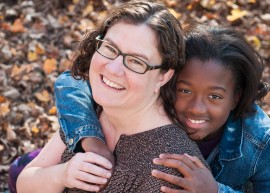May 2017 | As told by Beth

I wasn’t home for Christmas in 2012: I was in the hospital with mysterious respiratory symptoms, and a stubborn “walking pneumonia” that hadn’t responded to antibiotics or steroids.
The new year brought further challenges. Just after New Year’s Day 2013, I received a phone call with the official news that I had been diagnosed with advanced non-small cell lung cancer. I’d had a biopsy while I was in the hospital, so I knew cancer was a possibility. It seemed so impossible, though. All I knew about lung cancer was its association with smoking, and I had never smoked.
I didn’t know anyone with lung cancer or anyone who’d experienced it in their family, or so I thought. I felt alone and didn’t know where to go for help. At first I got most of my information from my doctors and was fortunate to have access to specialists at some of the top cancer centers in the country. When a thoracic surgeon told me that my cancer was Stage IIIb or IV, that I was not a candidate for surgery and that my cancer was not curable, I was devastated.
I will always be grateful to Dr. Biren Saraiya, the medical oncologist who managed my treatment for the first six months. He was patient, compassionate, and knowledgeable. With his help I came to understand that even if my disease couldn’t be cured, with treatment I could have a good quality of life.
When standard chemotherapy didn’t seem to be helping me, Dr. Saraiya encouraged me to find out what clinical trials might be open to me. I knew something about clinical trials from briefly being an AIDS activist in the 1990s, so I understood that trials could be the best way to get access to the newest and most promising treatments. Also, even if a trial medicine didn’t help me, at least by taking part in the trial I could help future patients by contributing to knowledge about this disease.
I had another biopsy, and my cancer tissue was sent off to be tested for any mutation or substance that might provide a clue as to what trial might be best for me. That testing resulted in a wonderful surprise, although at the time I had no idea how wonderful: my cancer had the ROS1 genetic mutation. The data was already showing that one of the new targeted therapies, crizotinib (now better known by the brand name Xalkori), was very effective against ROS1 cancer. The research team enrolled me in the study and I started taking crizotinib right away. The results were amazing: within days I felt better, and within months my cancer was no longer visible on CT scans.
I had never heard of Free to Breathe (now merged with the Lung Cancer Research Foundation) until my friend Michelle signed me up for a lung cancer walk in my hometown, Philadelphia. Years before, I had run a marathon to raise money for the Leukemia and Lymphoma Society in honor of Michelle, a lymphoma survivor. Now the tables were turned, and she organized a team to walk and raise money in my honor. We walked with our mothers and our children, and that year our team was one of the most successful at raising funds.
It’s been important to me to connect with other lung cancer survivors. I’ve taken part in two more Free to Breathe walks, and attended an action summit. I’m part of a lung cancer group on social media (hashtag: #lcsm) and a Facebook group especially for people with the ROS1 mutation. It’s through the community of survivors that I now stay up to date on current treatment news.
I think that this moment in lung cancer history is a little bit like the moment in AIDS history in 1996, when the combined power of engaged patients and inspired activists pushed research over a tipping point and all of a sudden a deadly disease became, for many, a chronic but manageable condition. We may not be quite at that tipping point yet, but I can’t help believing it’s very close.
Photo credit: Donna Uettwiller. Donna was part of Beth’s first Free to Breathe team, and Donna’s daughter won the 5K in her age group.